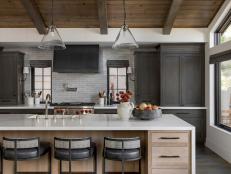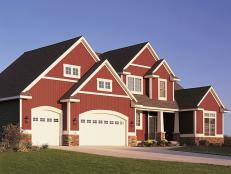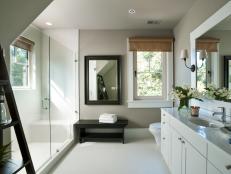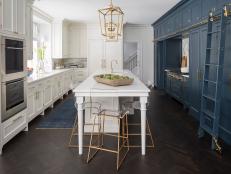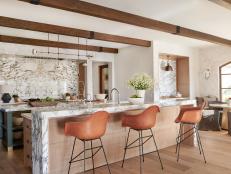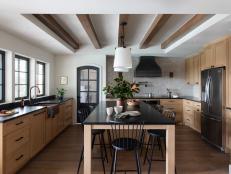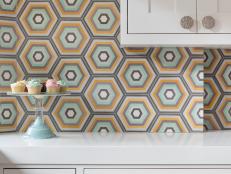Window-Term Glossary
Making design choices for the home can be challenging enough even when you understand all the factors influencing your decision. But window-buying takes the difficulty level to a new realm. The variety of terms and ideas one needs to understand when window-shopping can leave even experienced building professionals flustered.
Next time you're considering window choices for a project and find yourself confused about how certain ratings were determined or what a particular term means, you won't have to wish in vain for tools to decipher the window code. Just keep this glossary of terms on hand to clear up the foggy world of window ratings.
- Air leakage: Sometimes called "air infiltration," a window's air-leakage performance rating gives buyers a sense of how impermeable a given window is to air leaks, both from the inside out and from the outside in. A window's air-leakage rating is determined by measuring how many cubic feet of air pass through a square foot of window area under specific conditions. Lower numbers indicate better performance.
- Awning window: a top-hinged window that opens by swinging outward. Often found in basements or above non-operable picture windows.
- Casement window: a side-hinged window that swings outward to open
- Composite window: windows made from two or more materials. Common examples include fiberglass composites (fiberglass-reinforced polymer windows) and wood composites, which come from combinations of materials such as wood sawdust, scrap PVC and post-consumer recycled plastic.
- Condensation resistance: Condensation-resistance ratings provide an indication of the likelihood that water vapor will form on the inside glass of a given window product. It's rated on a scale of 0 to 100, with higher numbers indicating better condensation-resistance performance.
- Double glazing: A double-glazed window consists of two panes of glass with a spacer separating the panels. This space, particularly when gas-filled, limits temperature transmission and improves energy efficiency.
- Double-hung window: a window that has sashes that open from both the top and the bottom
- Energy Star rating: Energy Star ratings are administered by the U.S. Department of Energy's Energy Star program. For windows, Energy Star qualification criteria vary among the DOE's four climate zones (Northern, North/Central, South/Central and Southern) and are based on a product's performance in National Fenestration Rating Council testing.
- Fixed window: a window that doesn’t open. The term picture window is sometimes used as a synonym.
- Gas-filled window: double- and triple- glazed windows with inert gases between the panes of glass, which further improve the energy performance of the product by providing additional insulative properties. Argon is the most commonly used gas. Because it's denser than atmospheric oxygen, it reduces temperature transference between panes of glass. Also common are krypton gas, which is denser than argon, and xenon, which is denser than krypton. Unsurprisingly, argon is the least expensive gas-fill, followed by krypton and then xenon.
- Low-emissivity or low-E: Low-E coatings give window glass greater resistance to temperature transference by improving the glass's heat-reflectivity properties. Low-E coatings help trap heat on the same side of the glass it originated from.
- National Fenestration Ratings Council: a nonprofit organization that offers standardized ratings of windows, doors, skylights and other similar products. These tests are voluntary, but most major window manufacturers have their products rated (and any manufacturer who wants a product to qualify for Energy Star must submit to the tests).
- NFRC label: NFRC labels offer information on a model's U-value, solar heat gain coefficient (SHGC) and visible transmittance. Information on air leakage and condensation resistance may also appear but is not standard.
- R-value: R-value measures a substance's resistance to the flow of heat. It's most commonly used when discussing insulation products but is useful to understand when looking at windows because it's the inverse of U-value, which measures how heat-conductive a material is. A well-insulated window will have a low U-value (because it’s not a good temperature conductor) and a high R-value (because it resists the flow of heat).
- Sash: A window sash is the framework that holds the glass in place on an operable window.
- Single-hung window: A single-hung window looks much like a double-hung window, but only the bottom sash is operable, while the top sash is fixed in place.
- Solar heat gain coefficient: a measure of how well a window blocks heat gain from solar radiation. The rating ranges from 0 to 1, with lower numbers indicating better heat resistance.
- Spectrally selective coating: Spectrally selective coatings on energy-efficient windows block infrared light wavelengths that transmit heat while allowing visible light to pass through the window.
- Tempered glass: glass that has been processed and treated to increase its break resistance
- Triple-glazed: the same as double-glazed windows except that they use three panes of glass rather than two. Triple-glazed windows are extremely efficient but can be more expensive choices. They may also inhibit visible-light transmittance, which many homeowners find undesirable.
- U-factor/U-value: A window's U-factor measures a windows thermal conductivity. A lower U-factor indicates less conductivity and better efficiency.
- Visible transmittance: The visible transmittance (VT) rating indicates how much light passes through the glass, with higher numbers indicating greater light transmission.
- Wood-clad: A wood-clad window has a wood internal structure but is wrapped with a vinyl or aluminum exterior. This is intended to combine low maintenance with the superior insulative properties of wood, though some building-envelope specialists recommend against wood-clad windows for wet climates because of the possibility of moisture intrusion (and rot) if the cladding is at all compromised.







